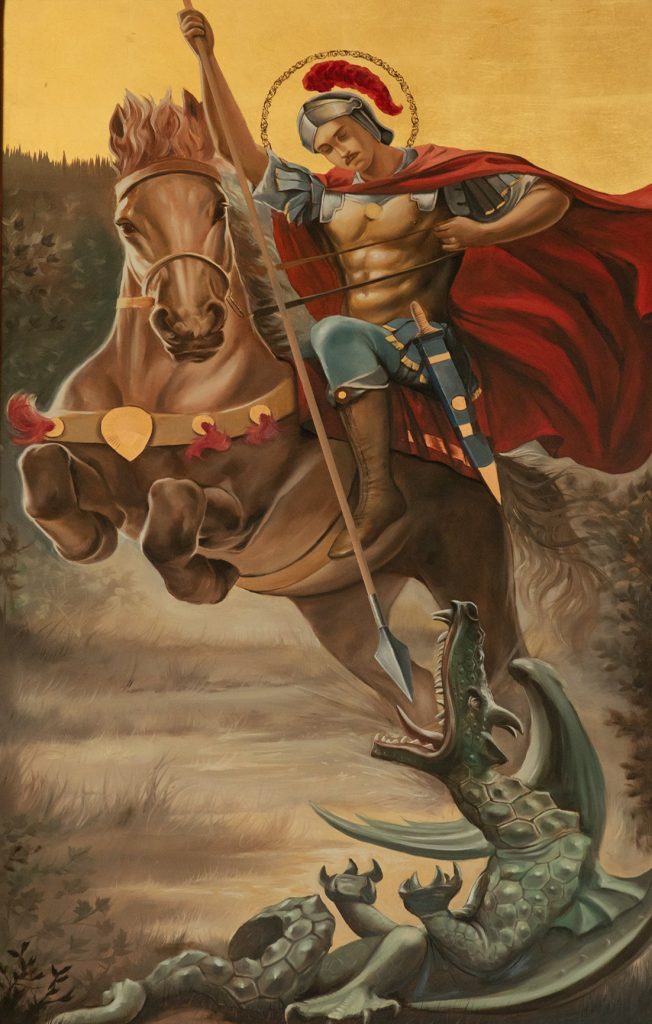St. George
Prince of Martyrs
"Now, therefore, you are no longer strangers and foreigners, but fellow citizens with the saints and members of the household of God.”
(Ephesians 2:19)

The Story In A Minute
Early Life
St. George is a celebrated saint with the story of his martyrdom being cherished throughout history. St. George has been named as the patron saint of England, Portugal, Venice, and Ethiopia, and many other locations.
Born in Cappadocia in Asia Minor - present-day Turkey - in the first half of the third century, St. George was born into a wealthy Christian family. His father, a governor, passed away when he was still young, causing St. George’s family to move back to his mother’s homeland–Lydda, Palestine.
When St. George grew and became a courageous and brilliant young man, the governor of Palestine took interest and enlisted him in the army. He was promoted in the ranks until he reached the rank of a commander. Meanwhile, the pious governor of Palestine departed. When St. George returned from the army and went to Lydda to visit his mother, he found that Emperor Diocletain had issued an edict to worship idols and torture the Christians who did not obey his orders. This resulted in many people worshipping idols.
His Sufferings
St. George came before the Emperor and confessed the Lord Christ. The Emperor marvelled at his appearance and courage and was informed that he was the son of an eminent governor. The Emperor befriended him and tried to persuade him to offer incense to the idols, promising to grant all his wishes.
George refused all the earthly futile promises and stood firm in his loyalty to Christ and his faith. The Emperor was furious and ordered to torment him with the most severe and horrific kinds of tortures. We are thus reminded of what Christ stated regarding the sufferings his believers would endure.
Christ said, “But beware of men, for they will deliver you up to councils and scourge you in their synagogues. You will be brought before governors and kings for My sake, as a testimony to them and to the Gentiles”
(Matthew 10:17-18)
During St. George’s tortures, the Lord consoled him and healed his wounds. The Emperor even ordered Athanasius, a magician, to give St. George a cup filled with poison. St. George made the sign of the cross over the cup, drank it, and was not harmed! After witnessing this miracle, Athanasius believed in Jesus Christ. The Emperor then ordered Athanasius' death, and he received the crown of martyrdom.
A Great Miracle
The Emperor became enraged and ordered the torture of St. George by squeezing him until he delivered his soul. Then, they cast his body outside the city. However, the Lord Christ raised him up, and the saint returned to the city.
When the people saw him, three thousand and seven hundred souls believed. The Emperor ordered to cut off their heads, and they received the crown of martyrdom.
In The Emperor’s Palace
St. George continued to be tortured until Diocletain became weary and bored. He started to be pleasant to the saint and promised to give him his daughter in marriage if he would offer the incense to his gods. The saint pretended to accept his offer, and the Emperor rejoiced and brought him into the royal palace.
While St. George was praying the Psalms, the Empress heard him and asked him to explain to her what he had said. He began to interpret to her all the events from the creation of the world to the Incarnation of the Lord Christ, and his words entered her heart and she believed in the Lord Christ.
In The Temple
The Emperor called upon all the men of the city to see St. George offering incense to the Emperor's gods. In the temple, the saint spoke to the idol in the name of the Lord Christ and asked him to clearly state his identity. The devil was forced to answer through the idol and said, “I am not a god myself or any other idol like me. But the true God is the one that you are proclaiming.”
Immediately after that, all the idols fell and were destroyed. The priests of the idol became furious and stirred up the people, screaming in the face of the Emperor saying; “Take his life for we can’t tolerate seeing him anymore.”
The Empress told the Emperor:
"Didn't I tell you not to oppose the Galileans, for their God is strong and mighty?"
